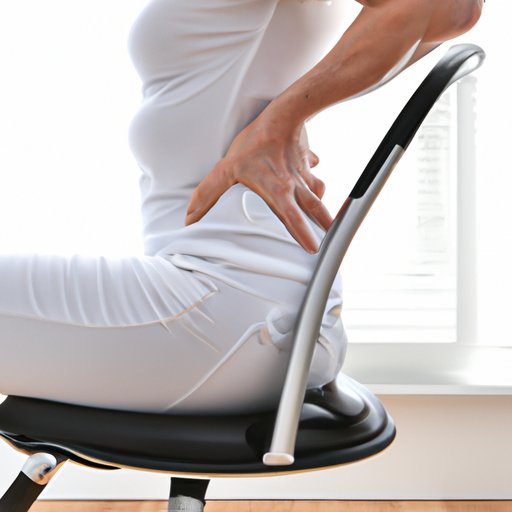I. Introduction
Are you experiencing pain in your lower back or one of your legs? Do you feel like an electric shock is running down your leg? Chances are you may be suffering from sciatica. Sciatica is a condition that affects millions of adults and can considerably impact their quality of life. In this comprehensive guide, we aim to help you understand sciatica and find practical solutions to alleviate the symptoms.
II. Education is Key
What is Sciatica? Sciatica is a condition that happens when your sciatic nerve, which starts in your lower back and runs down to your hip and leg, is compressed or pinched. The symptoms may include lower back pain, leg pain, numbness, tingling, weakness, or burning in the affected area.
Why Educating Yourself is Important One of the primary reasons to educate yourself about sciatica symptoms and causes is to identify the problem early on. Early identification may help you avoid future complications and lead to a quicker recovery. Additionally, knowledge about sciatica can help you communicate more effectively with your physician, which can lead to more accurate diagnosis and treatment.
Seeking Professional Help If you suspect that you have sciatica and are experiencing pain, you should consult a healthcare professional soon. A physician can diagnose sciatica by conducting a physical exam and ordering imaging tests such as an MRI or X-rays to confirm the diagnosis. Your healthcare professional will then provide a treatment plan to alleviate your symptoms and get you on the path to recovery.
III. Primary Treatment for Sciatica
Hot and Cold Therapy Hot and cold therapy is a simple, non-invasive way to relieve pain and muscle tension. Applying heat to the affected area can help reduce tension and increase blood flow to the area. Conversely, applying ice can help reduce inflammation and swelling. You can use hot or cold packs, which are readily available at pharmacies, or alternate between the two.
Exercise and Stretching Exercise is another effective way to relieve sciatica pain. Exercises focused on strengthening and stretching can help the muscles that support your spine and improve your flexibility. Common exercises include walking, cycling, or simple stretches, such as the knee-to-chest stretch or seated spinal twist. A physical therapist or chiropractor should be able to recommend exercises that suit your individual needs.
Managing the Pain Non-invasive treatment for sciatica mainly focuses on reducing the patient’s pain and improving their quality of life. Using the techniques mentioned above can help to relieve pain. These treatments are also less expensive and may avoid the need for medication and surgery.
IV. Over-the-Counter Pain Relievers
NSAIDs and muscle relaxants Nonsteroidal anti-inflammatory drugs (NSAIDs) such as ibuprofen and naproxen can help to alleviate pain and reduce inflammation. Muscle relaxants such as cyclobenzaprine can help to reduce muscle spasms, which can cause sciatica pain. However, you should always consult your physician or pharmacist before taking any medications to avoid any interactions or side effects.
V. Physical Therapy and Rehabilitation
Treating Sciatica through Physical Therapy and Rehabilitation Physical therapy may help in reducing pain and preventing re-occurrence of sciatica. Treatment usually involves stretching and strengthening exercises to improve mobility and flexibility. Additionally, physical therapists may use therapies like ice or heat therapy, ultrasound, and massage to help further relieve pain. If you are considering physical therapy, speak with your physician regarding the specific form of therapy, costs, and insurance coverage.
Choosing the Right Physical Therapy It’s essential to choose a trustworthy Physiotherapist to avoid further complications. Check for their qualifications, degree, and credentials. Check the reviews given by their previous patients on their website or third-party platforms. Pick a professional who makes you comfortable and with whom you can voice your specific needs.
VI. Alternative Treatments
Treating Sciatica with Acupuncture Acupuncture involves placing tiny needles at specific acupoints, which stimulates the body’s natural pain-relief mechanisms to alleviate pain. While it may sound daunting, the treatment is usually painless and effective. A typical session takes about 30-45 minutes.
Massage Therapy and Sciatica Relief Massage therapy may also be effective in helping to relieve pain. During a massage, the therapist manipulates the soft tissue, which can help to increase blood flow and reduce muscle tension. Techniques that have proven effective for sciatica include deep tissue massage and trigger point therapy.
VII. Medical Intervention
Surgery and Injections When all other treatments fail, medical intervention may be necessary. Lumbar laminectomy is a type of surgery that involves removing the part of your vertebrae that is compressing your nerve root. Alternatively, your doctor may recommend corticosteroids injected into the affected region to reduce inflammation and control pain.
Professional Assessment It’s essential to get yourself assessed by a professional before opting for medical intervention. A comprehensive assessment may reveal underlying conditions that are contributing to your sciatica symptoms. Your physician may recommend weight loss, proper posture, ergonomic workspaces, and other lifestyle changes to help manage your condition.
VIII. Conclusion
In conclusion, sciatica can be painful and challenging to manage. However, with enough education and care, it’s possible to alleviate its symptoms and prevent reoccurrence. Remember to seek professional help and use the non-invasive methods discussed in this guide to manage sciatica pain. Whether you opt for physical therapy, acupuncture, or medical intervention, it’s critical to trust your healthcare professional and adhere to their treatment plan.
